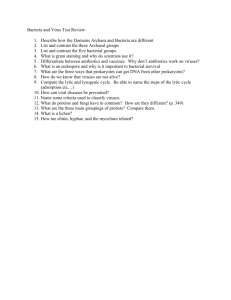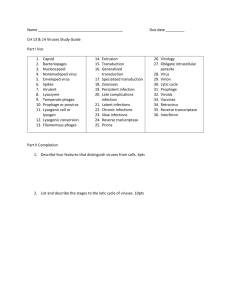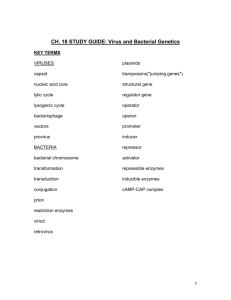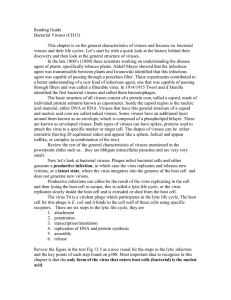Virus notes - Faculty Sites
advertisement
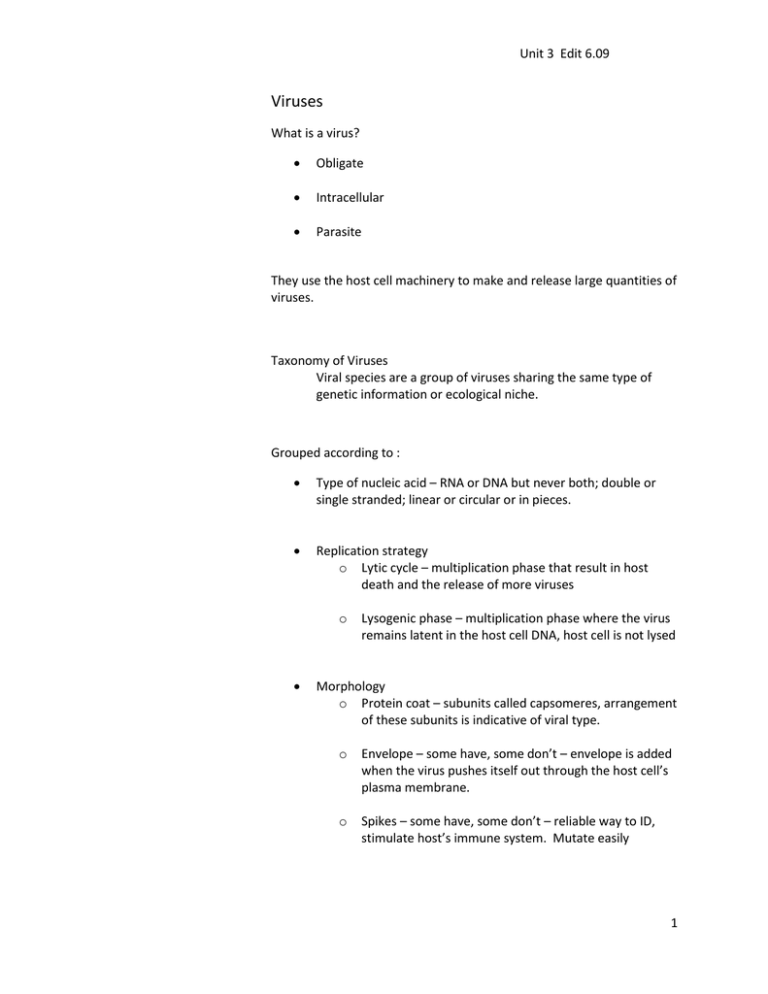
Unit 3 Edit 6.09 Viruses What is a virus? Obligate Intracellular Parasite They use the host cell machinery to make and release large quantities of viruses. Taxonomy of Viruses Viral species are a group of viruses sharing the same type of genetic information or ecological niche. Grouped according to : Type of nucleic acid – RNA or DNA but never both; double or single stranded; linear or circular or in pieces. Replication strategy o Lytic cycle – multiplication phase that result in host death and the release of more viruses o Lysogenic phase – multiplication phase where the virus remains latent in the host cell DNA, host cell is not lysed Morphology o Protein coat – subunits called capsomeres, arrangement of these subunits is indicative of viral type. o Envelope – some have, some don’t – envelope is added when the virus pushes itself out through the host cell’s plasma membrane. o Spikes – some have, some don’t – reliable way to ID, stimulate host’s immune system. Mutate easily 1 Unit 3 Edit 6.09 Examples: Tobacco mosaic Virus – helical Adenovirus – Polyhedral Bacteriophage – Complex Culturing Viruses is difficult Often can only be cultured with host cells Culture Methods In living animals (host cells) o Advantages o Problems 2 Unit 3 Edit 6.09 Embroynated eggs o Advantages o Problems Cell cultures o Advantages o Problems Bacterial Replication – most of this information known by studying bacteriophages Most viruses only contain a few genes (structural components), the host provides enzymes for protein synthesis, replication, etc. Two types: Lytic cycle and Lysogenic cycle Lytic Cycle stages Attachment Penetration Biosynthesis Maturation Release Lysogenic Cycle Stages Penetration Phage DNA combines with host cell DNA 3 Unit 3 Edit 6.09 Spontaneous event can lead to excision of phage DNA and initiation of lytic cycle o Results of lysogenic cycle 1. Immune to infection by another of same virus 2. Phage conversion = new properties 3. Specialized transduction – pieces of bacterial DNA are packaged in virus coat and moved Terminology Burst time Burst size Eclipse time Animal Virus Replication is different Penetration by endocytosis Exit by budding Receptor sites are inherited Uncoating Viruses and Cancer Can go unrecognized because the viruses invade but do not cause cancer immediately Not contagious as most viral diseases Virus can be activated to abnormal function by mutagenic agents 4 Unit 3 Edit 6.09 Vertical gene transfer – plants and animals transfer genes to their offspring Horizontal gene transfer – Bacteria can transfer genetic material to each other as well as their offspring. Conjugation Transduction Transformation Conjugation Plasmid = circular DNA Requires cell to cell contact Opposite mating type Plasmid carries gene for sex pili Transduction Bacterial DNA broken down by viral enzyme Pieces of bacterial DNA packaged in new viruses Transferred to new host cell Recombination Specialized transduction – only particular genes are transferred via transduction 5 Unit 3 Edit 6.09 Transformation Genes are transferred as naked DNA from one bacteria to another and recombination occurs Frederick Griffith, 1928 6
